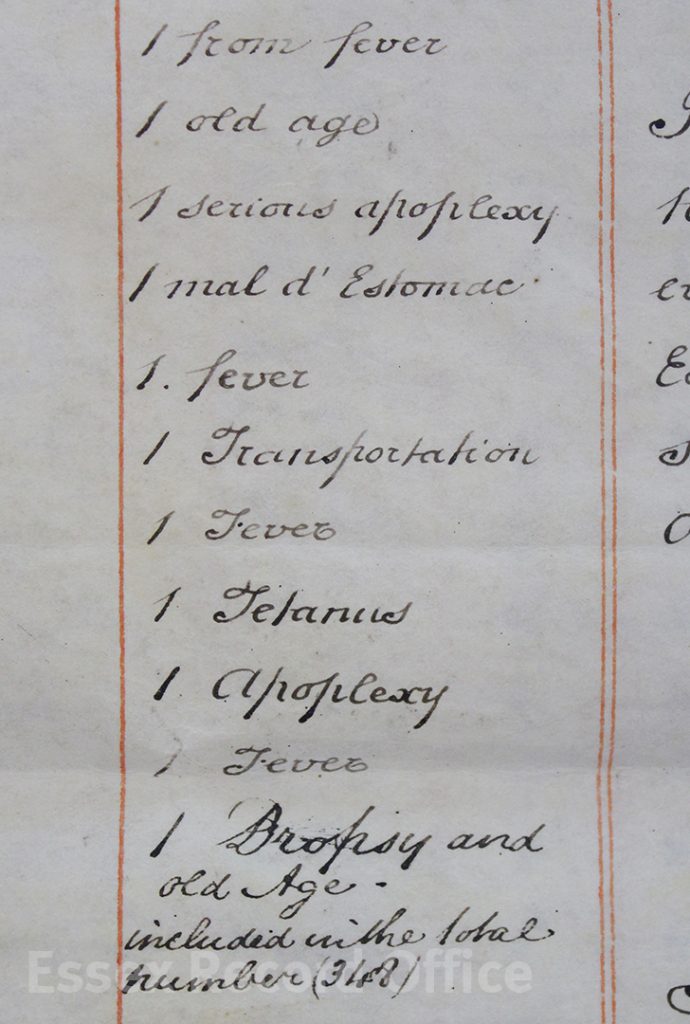23 August is Slavery Remembrance Day, which seemed an appropriate moment to highlight this document, which is one of the darker things in our collection.
The document dates from 1822 and is part of a series of papers which relate to the administration of the estate of Stella Frances Allen, née Freeman, who had died in 1821 (D/Dc F9/8). Stella had inherited estates owned by her family in Jamaica, which relied on slave labour, and this document lists the slaves who were at work on the family’s Belvidere plantation in the parish of St. Thomas-in-the-East in Jamaica. The lists give the name, colour, and age of the slaves, and whether they had been born in Africa or the West Indies.

The lists of enslaved people stretch over four substantial parchment sheets

The documents were compiled by George Cuthbert, who seems to have been the Freeman family’s agent on the Belvidere estate

The document lists the names, ‘color’, and ages of the enslaved people forced to work on the estate, and whether there were born in Africa or the West Indies
In the ‘color’ column, people are listed as being either ‘Negro’, ‘Sambo’, ‘Mulatto’, or ‘Quadroon’ – terms which today are considered offensive and have fallen out of use. These terms were used at the time to categorise people based on their skin colour and ancestry; definitions for these terms are given in the Oxford English Dictionary as follows:
- ‘Negro’: a person of Black African origin or descent
- ‘Sambo’: this word seems to have several meanings, and was often used as an offensive nickname for Black people. It could also be used to mean someone who had one ‘Negro’ parent and one ‘Mulatto’ parent.
- ‘Mulatto’: a person with one white parent and one Black parent
- ‘Quadroon’: a person with one Black grandparent
The fact that people were categorised in this way based on the colour of their skin, and the skin colour of their ancestors, is deeply uncomfortable to read today, but provides a stark insight into the mindset of the time.
Another column, titled ‘African or Creole’, gives an indication of where each person was born, i.e. whether in Africa, or in the West Indies. One man, John Williams, aged 55, is described in this column as ‘American’.
There are actually two lists, or schedules, in the document; one from 1817 and the other from 1820. In 1817 there were 355 enslaved people engaged in forced labour on the estate – 182 men and 173 women – and in 1820 there were 348. The 1820 schedule notes that since 1817 there had been 21 births and 28 deaths amongst the enslaved people on the plantation. The reasons for deaths are given, including fever, old age, ‘mal d’Estomac’ (literally, a ‘bad stomach’), tetanus, and dropsy. One enslaved man, John Whitfinch, was named but noted to have ‘run away since 1818’.

Part of the 1820 schedule which records reasons of death, and curiously also one case of ‘transportation’
Perhaps especially disturbingly, there are also several children, toddlers and babies listed, including in 1817 Biddy, aged 5 days, daughter of Aneilla Mowatt, and Penny, 1 month, daughter of Jane Williams. Sometimes it is possible to identify three generations amongst the enslaved worker: 9-year-old Clara was the daughter of Henny Richard, aged 30, whose mother was Mary Richards, aged 55.

Some of the very young children listed on the 1817 schedule
Even though the slave trade had been abolished in Britain in 1807, the whole system of slavery in British-held territories was not abolished until 1833. The British government granted £20 million in compensation, to be paid by British taxpayers, not to the slaves themselves, but to the slave owners who were losing their ‘property’. Stella Allen had already died by this point, and the compensation for the slaves she had owned was paid to her executor, Capel Cure of Blake Hall in Bobbingworth (detailed in Stella Freeman’s entry on the Legacies of British Slave-ownership project).
Seeing this list of people ‘owned’ by other people is a chilling experience, and reminds us that much of the wealth of Britain at that time was built on the horrendous practices of enslavement.
A search on Essex Archives Online for the word ‘slave’ brings up 76 results; there are plenty of other stories relating to this dark period in our history waiting to be uncovered.

Thought provoking, disturbing, and very sad. I appreciate this window into the past and thank you for providing it.